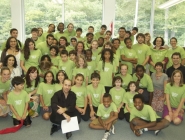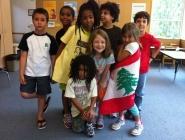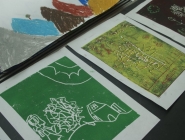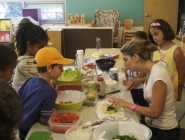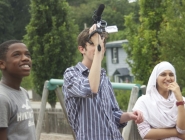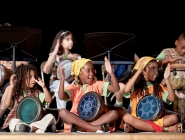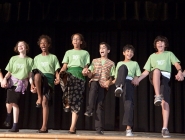Al-Bustan Camp had a fantastic 10th anniversary program in 2011. We had a dynamic team of educators, teaching artists, and counselors, all of whom gave so much of their time and energy to a wonderful group of campers that hailed from a diversity of backgrounds.
Learning about the arts, culture and environment of Lebanon, the campers presented a culminating performance and exhibit on July 28. The evening began with short scenes that the campers had prepared in Drama Class based on personal accounts of those living in Lebanon and stories from Lebanese publishing house Dar Onboz founded by Nadine Touma.
Group Ta’ drew on stories that architect Abdallah Tabet relayed to the Campers about growing up in Lebanon during the Civil War to compose a scene about the disruption to daily life that the Civil War caused. The characters in Group Ta’s scene wait in a shelter for the violence of the Civil War to end. While they wait they tell a fantastical story inspired by Nadine Touma’s Seven Plus 7, which Group Ba’ presented as their scene. Group Alif entertained everyone with their play The Boy Who Wanted to be the Moon, which encouraged us all to embrace who we are.
The precision and coordination of the campers’ group percussion and dance performances wowed the audience. Percussion and Dance instructor, Hafez Al Ali Kotain, introduced campers to the music and dance of Lebanon including Yaba Yaba Lah by Tony Hanna and Al Ayn Mulaitain by Samira Tawfik. In addition to presenting their prepared percussion medleys, all three groups finished with a call and response.
The Shabab, Arabic for “teens,” debuted Through the Camera’s Eye, a short film that they worked to create over the three weeks in Video Class. The film embraced the discussions they had under the guidance of media educator Suzy Salamy about stereotypes, including what characterizes an ideal American. Their film was comprised of interviews with pedestrians in Center City as well as short narrative pieces depicting situations of discrimination. In addition they stunned the audience with their powerful poetry. As they read their poems, images of their artwork were projected on the screen behind them.
Each group delighted the audience with a song by legendary Lebanese singer Fairouz that they had learned in Singing Class. Campers performed the classic songs Tik Tik Tik, Kan Enna TaHoon, and Amara Ya Amara. So moved by her camp experience, Gaida, our singing teacher and acclaimed singer in her own right, composed an Al-Bustan Camp song. The song celebrates a sense of community based on friendship and a shared appreciation for Arab culture that Al-Bustan Camp has fostered for 10 years. “Love and seeds we grew and watered, hope and knowledge, we planted and built.” The evening drew to a close with Groups Ba’ and Ta’ singing the song.
In addition to the performance, examples of the campers’ experience in their other classes were on display in the auditorium. The books of Dar Onboz and the geography of Lebanon informed the trajectory of Art taught by Tremain Smith. The books are visually stimulating–communicating the story line not just through text but through images, including many collages. Beginning with explorations of the elements of drawing, including line, texture, space, value, and color, campers made materials to be used in collages. Campers created individual collages while also working on a collaborative project using collage to depict the 28 letters of the Arabic alphabet.
The walls of the auditorium were also filled with campers’ artwork inspired by the varied geography of Lebanon. Groups Alif and Ba’ used drawing and printmaking to depict Lebanon’s coast, mountains, and iconic cedars. This landscape informed many poems that campers wrote in poetry class.
While Groups Alif, Ba’, and Ta’ did not recite their poems, their works responding to what they learned about Lebanon filled an anthology that poetry teacher Eric Hitchner assembled. Integrating what they learned in poetry and art classes, campers filled large scrolls with their poems and Arabic letters cut out from their doodles and collages.
Also on display in the auditorium was the olive oil soap made by campers during science class. Following the technique practiced in Lebanon of making soap from the country’s abundance of olives, campers made orange blossom and lavender scented soap with science teacher Mary Walsh.
We hope the learning process continues as participants share what they experienced at Camp with friends and family. Thanks to all the staff, participants, and families for their keen interest and boundless support!
Video Produced by Teen Campers: Through the Camera’s Eye
Media educator Suzy Salamy, who worked daily for three to four hours over 15 days with nine teenagers at Al-Bustan Camp 2011, reflects on the experience…
Working with the teens was as much a learning experience for me as it was for them. They all brought so much energy and personality to the table that it made each day fun. I followed a social justice curriculum dissecting race, class and gender. We also connected these threads to the Arab world. The curriculum analyzed media images like commercials and mainstream movies through the lens of societal oppression. Once the teens had these tools of analysis we went ahead and learned the basics of story boarding, shooting video, editing and shooting street interviews.
When it came time to decide what to do for the final project I left it open for them. They decided to shoot two short narrative pieces that they created from scratch and then to mix it with documentary style interviews from the streets of Philadelphia. The short narrative stories and the interviews were connected by topic.
The teens created a list of questions that they asked each interviewee. The questions related back to their education about different forms of oppression. When it came time for editing they spliced in these interviews to match and complement the short narrative pieces.
Each teen contributed to the project in his/her own way. Some teens excelled in shooting, others preferred editing, while others enjoyed acting. Together they put together a fantastic video that illustrates their abilities individually as well as their strength as a team.
Enjoy the video and see what three weeks can create!


